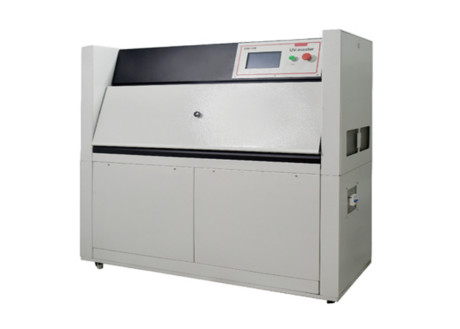6 Features of UV Aging Tester
UV Accelerated Weathering Tester 6 Features:
1. Simulate sunlight: Ultraviolet rays in sunlight are the main factor causing damage to the durability of most materials. We use UV lamps to simulate the short-wave UV portion of sunlight, which produces very little energy in the visible or infrared spectrum. We can choose UV lamps with different wavelengths according to different test requirements, because each lamp has different total UV radiation energy and wavelength. Generally, UV lamps can be divided into two types: UVA and UVB.
2. UV lamp type:
UVA-340 Lamp: The UVA-340 lamp is an excellent simulation of the short-wave ultraviolet light in sunlight, i.e., the wavelength range from 365 nanometers to the sunlight cut-off point of 295 nanometers.
UVB-313 lamps: UVB-313 lamps emit short-wave ultraviolet light that is stronger than the sun's ultraviolet rays that normally irradiate the earth's surface, which can accelerate the aging of materials to a certain extent. However, the tube may cause unrealistic damage to certain materials. UVB-313 lamps are mainly used for quality control and research and development, or to run tests on extremely weather-resistant materials.
UVA-351 lamp: simulates the ultraviolet light of sunlight passing through the window glass, it is most effective for testing the aging of indoor materials.

3. Wet condensation environment: In many outdoor environments, the wet time of the material can be as long as 12 hours per day. Research has shown that dew, not rain, is the main contributor to this outdoor wetness. UV simulates outdoor moisture erosion through a unique condensation function. During the condensation cycle during the test, the water in the reservoir at the bottom of the test chamber is heated to generate hot steam, which fills the entire test chamber. The hot steam maintains the relative humidity in the test chamber at 100% and maintains a relatively high temperature. The specimens are secured to the side walls of the test chamber so that the test surface of the specimen is exposed to the ambient air in the test chamber. The outer side of the sample exposed to the natural environment has a cooling effect, resulting in a temperature difference between the inner and outer surfaces of the sample. The appearance of this temperature difference causes the test surface of the sample to always have liquid water generated by condensation during the entire condensation cycle.
Since outdoor exposure to moisture can be as long as a dozen hours a day, a typical condensation cycle typically lasts a few hours. UV provides two moisture simulation methods. The most widely used method is the condensation method, which is a good way to simulate outdoor moisture erosion. All QUV models can run a condensation cycle. Because some application conditions also require the use of water spray for practical results, some UV models can run both a condensation cycle and a water spray cycle.
4. Temperature control: In each cycle, the temperature can be controlled at a set value. At the same time a blackboard thermometer can monitor the temperature. The increase in temperature can accelerate the aging process, and at the same time, temperature control is also very important for the reproducibility of the test.
5. Water spray system: For some applications, water spray can better simulate the environmental conditions of final use. Water spray is very effective in simulating thermal shock or mechanical erosion due to temperature shocks and due to rain washout. Under certain practical application conditions, such as sunlight, when the accumulated heat is rapidly dissipated by a sudden rain shower, the temperature of the material changes dramatically, creating thermal shock, which is a type of thermal shock for many materials. test. Water spray from UV can simulate thermal shock and/or stress corrosion. The sprinkler system has 12 nozzles, six on each side of the test chamber; the sprinkler system can run for a few minutes and then shut down. This short spray of water quickly cools the sample, creating thermal shock conditions.
6. Irradiation intensity control: The optional irradiation intensity control option can obtain accurate and repeatable test results; the light intensity control system allows users to set different light intensities according to different test requirements. Precise control of illumination intensity through its feedback loop device; also prolongs the life of fluorescent lamps
The characteristics of the UV Accelerated Weathering Tester are the above. If you have more information about the quotation of the UV aging tester, please leave us a message!
2022-03-07 10:32
- Related News
Automatic Cross-Hatch Tester | PV 3952, Ford BN 108-03,GM N 14688 Compliant
Multi-Finger Scratch/Mar Tester | Automotive Plastics & Interior Materials T
Dental Material Color Stability Tester | ISO 4049 / YY 0270 / ASTM G155 Complian
Masks Bacterial Filtration Efficiency (BFE) Tester | YY 0469 / ASTM F2100 / BS E
Smoke Density Tester | ASTM E662 / ISO 5659-2 Compliant
Dry Microbial Penetration Resistance Tester | ISO 22612 / YY/T 0506.5
Dry Fallen Wadding Tester — YY/T 0506.6 | ISO 9073-10 | EN 13795-2
Fogging Tester | Automotive Interior Volatile Fogging Test System
